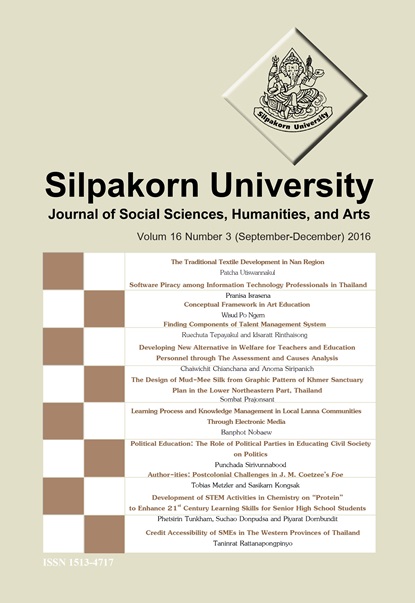Conceptual Framework in Art Education
Main Article Content
Abstract
This research was aimed to study and develop a conceptual framework in Art Education by analyzing related academic documents and 257 research conducted by graduate students in Art Education at Chulalongkorn University and Srinakarinwirot University during 2002-2012. Then the findings were analyzed, synthesized and created a conceptual framework by means of descriptive statistics including frequency, and percent. The results showed: 1 The meaning of Art Education was providing Art Education to learners to equipped them with good personality and traits so they could have free expressions according to their creative thinking and free imagination. Art Education learning activities included painting, molding, carving, printing, and art appreciation. Instructors organized instructional experiences based on the educational concept of developing each individual learner to his or her full physical, emotional, intellectual, perceptive, aesthetic awareness, and creative potential. 2. The content analysis obtained from 6 academic texts in Art Education found the main contents, namely 1) history of Art Education; 2) foundation and principles of Art Education that covered (2.1) philosophy of Art Education, (2.2) principles of Art Education, and (2.3) Art Education psychology; 3) the Art Education curriculum and instruction included (3.1) Art Education curriculum, (3.2) Art Education instruction, and (3.3) instructional media in Art Education; 4) management of Art Education / educating art teachers, and; 5) research methodology in Art Education. 3. Topics of research in Art Education showed most of the topics were research on art instruction (44.35 %), secondly, research on analysis of artworks in visual arts (34.24 %), and thirdly, research on teaching media, materials, and equipment in art instruction (7.39%). 4. The development of a conceptual framework in Art Education yielded 6 major components, namely 1) the context of art instruction, 2) Art Education management/ development of art teachers, 3) research in Art Education, 4) cores of Art Education, 5) education management of art, and 6) art learning outcome.
Downloads
Article Details
All rights reserved. Apart from citations for the purposes of research, private study, or criticism and review,no part of this publication may be reproduced, stored or transmitted in any other form without prior written permission by the publisher.
References
Arnheim, R. (1954) Art and Visual Perception. Berkeley and Los Angles: University of California Press
Bates, J. K. (2000) Becoming an Art Teacher. United States: Wadsworth
Bruner, J. S. (1971) Toward a Theory of Instruction. Cambridge Massachusetts: Belknap Press of Harvard University Press.
Campbell, L. H. and Simmon, S. III. (2012) The Heart of Art Education: Holistic Approaches to Creativity, Integration, and Transformation. United States: National Art Education Association.
Kaewdang, R. (2004) Prakaikam: The Dawn of Wisdom, Jewel of Thai Education Reform. Bangkok: Office of the Education Council.
Laistrooglai, A. (2009) Why the “Creative Economy”: Collection of Articles Urging Adrenalin.
Bangkok: Thailand Creative & Design Center (TCDC).
Logan, F.M. (1987) Growth of Art in America School. New York: Harper Brother.
Mahakhan, P. (1988) Art in Elementary School. Bangkok: Odean Store.
National Economic and Social Council. (2007) Summary Conclusion of the National Economic and Social Development Plan No.10th [Online URL : https://www. nesdb.go.th/ Portals/0/news/plan /p10/plan10/book/] accessed on July 15, 2012.
Pongsamart, C. (1983) Art for Secondary School Teachers, 2nd ed. Bangkok: Charoenwit Publishing.
Piaget, J. (1972) Psychology and Epistemology: Towards a Theory of Knowledge. Harmondsworth, Middlesex: Penguin.
Ponpai, P. (2001) Knowledge Management: Concepts and Case Study. Master’s Thesis, Faculty of Political Science, Chulalongkorn University, Bangkok.
Sawasdibut, N. T. (1982) Art and Elementary School Teachers. Bangkok: Trironasarn Publishing.
Schubert, W. H. (1986) Curriculum: Perspective, paradigm and possibility. New York: Macmillan.
Stafield, N. F. (1958) Handbook of Art Teaching in Tropical Schools. Evans Africa: Metric.
Suwanwela, C. (2008) Textbooks and Development of Thai Higher Education. In the workshop seminar on writing, producing, and publishing academic books, 2-3 Chula Weekly Newsletter, Bangkok: Chulalongkorn University Publishing.
Tangcharoen, M. (1995) Art Education. Bangkok: Odoen Store.
Thong-ngam, L. (1997) Report about Research and Development for Tools Used for Screening Students Grades 1-4 Who Are Gifted in Art Education at the Demonstration School at Srinakarinwirot University (Elementary). Demonstration School of Demonstration School at Srinikarinwirot 1995, Prasanmitr (Elementary).
Ua-anant, M. (2002) Art Education: Background, Principles, Evolution in Curriculum,
Teaching Theories, and Research. Bangkok: Chulalongkorn University Publishing.
Victor, L. (1957) Creative and Mental Growth, 3rd ed., New York: Macmillan
Wongyai, W. (1986) Curriculum Development and Teaching: New Dimension. Bangkok: Rungruangdham Publisher.


